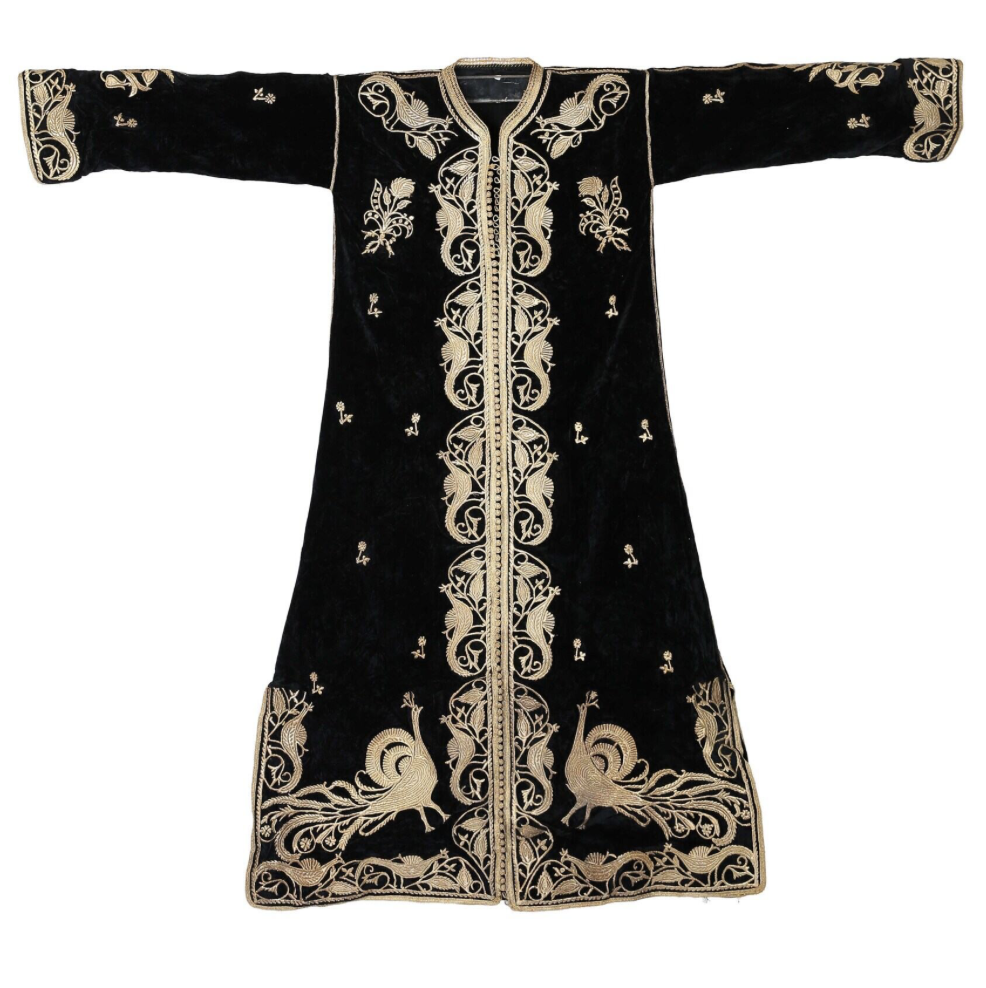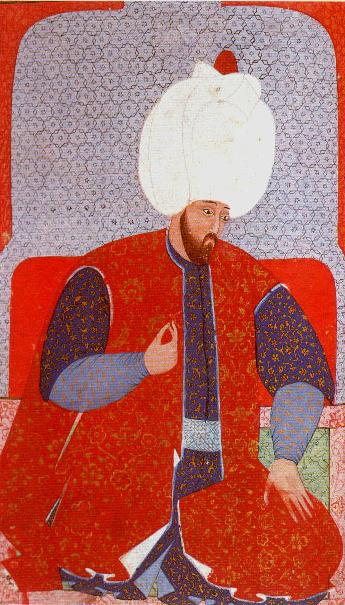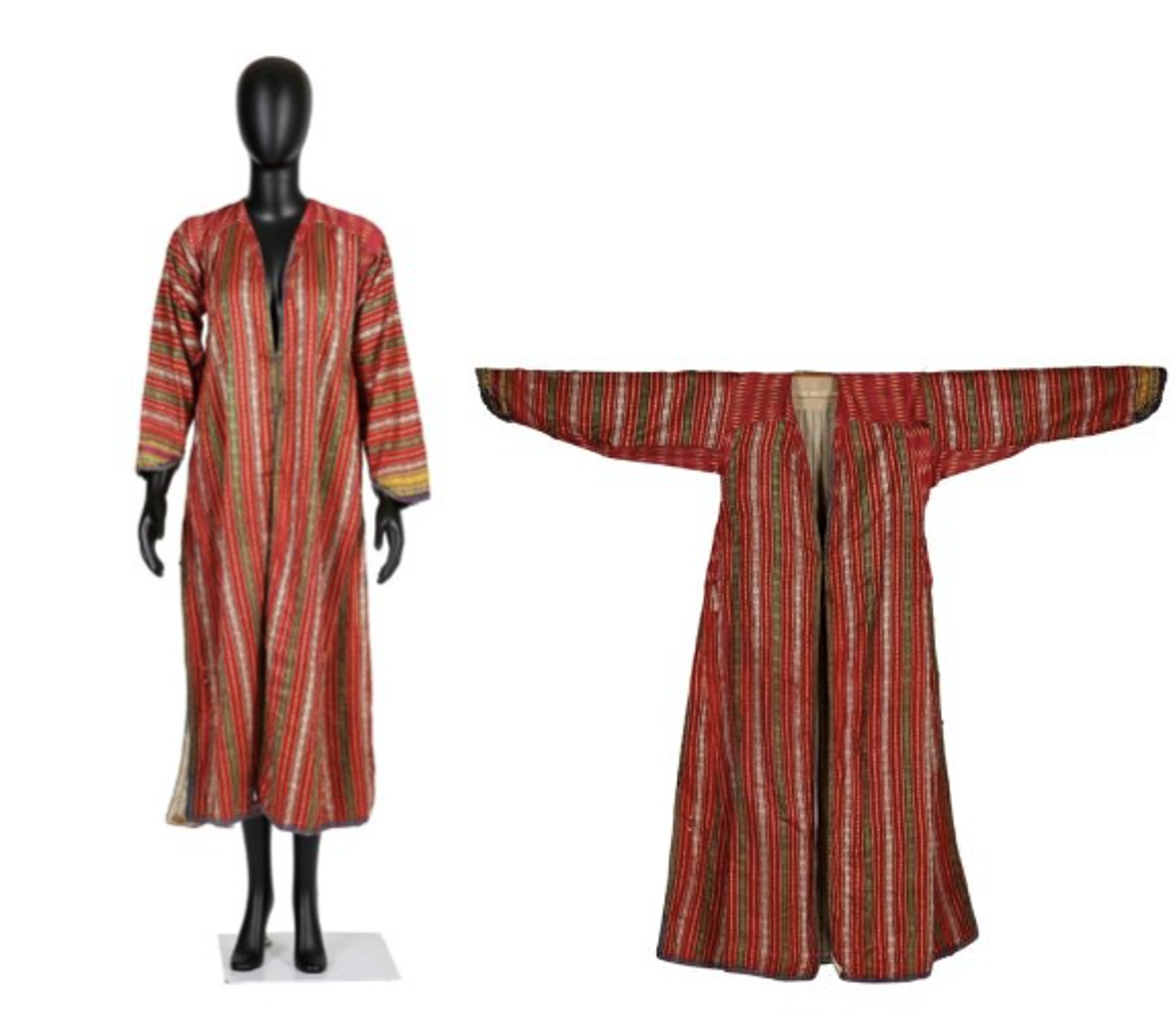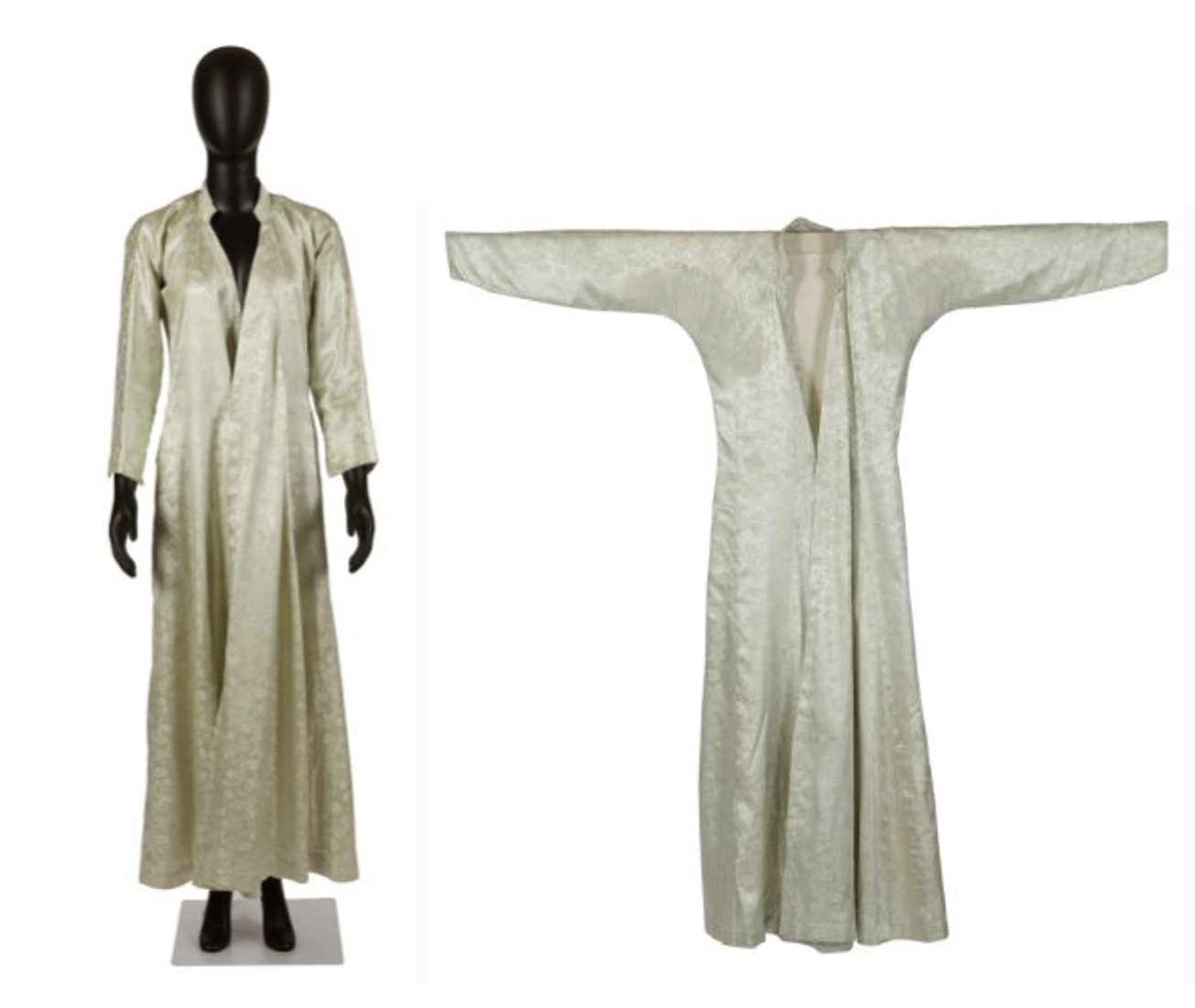




Introduction
Following our discussion on the origin of the kaftan in the previous segment, which spans from Central Asia to the Caucasus, we will now examine its spread within the global fashion landscape under Ottoman patronage. This segment of the article will retrace the kaftan’s journey into the Arab world, with a particular focus on Arab North Africa.
The Ottoman Influence
The Ottoman Empire (c. 1299 – 1922) played a crucial role in populariszing the kaftan, particularly in Middle and Near Eeast and around the Mediterranean. During c. 16th century, the kaftan became an essential garment for sultans and high-ranking officials, often layered for both stylistic and practical reasons. These ornate kaftans, made from rich materials and elaborate embellishments, were frequently gifted to important visitors and political figures. An example of this is the kaftan belonging to Suleiman the Magnificent, which was recently restored, underscoring its continued cultural significance.

The Ottoman Empire, drawing from Seljuk influences in Anatolia and integrating Western elements from Italy, developed a highly sophisticated and luxurious textile tradition characteriszed by bold and delicate designs. Kaftans were traditionally worn by the Ottoman sultans, serving as symbols of rank and status. The decoration of the garment, including its colours, patterns, ribbons, and buttons, was indicative of the wearer’s position within the hierarchy. In the first half of the 14th century, Orhan Ghazi captured Bursa and established it as the Ottoman capital. Bursa was renowned for its gold embroidery and other weaving specialities.
Following the Ottoman conquest of Istanbul in 1453, the Turkish ‘lonca’ (Islamic guild) system, infused with religious characteristics, supplanted the Byzantine guild system. Post– 15th century, textiles assumed a significant role in the social and economic fabric of the Ottoman classical period. The textile industry came under the purview of the Ehl-i Hiref organiszation, which operated under the centraliszation efforts of the Ottoman government.
During the reign of Sultan Mehmed II (1444-1446, 1451-1481), silk velvets ‘kedife’ (pile floss Floss: (Old French: flosche – nap of velvet), is a type of silk fibre obtained from the cocoons of wild silkworms. It is characterized by its long, fluffy fibers that are not tightly woven, making it ideal for use in various textile applications such as embroidery, lace-making, and sewing. fabric) (from Arabic: قَطِيفَة qaṭīfa, meaning plush velvet) were produced by Kadife-i bâfâns, who were part of or under the control of the Ehl-i Hhiref in Bursa. The Ottoman conquest of Caffa in 1475 disrupted Genoese control over trade in the Black Sea and Caffa, establishing Bursa as the centre of silk trading.
Historical records from the Bursa Kadı Sicil reveal that velvets with metallic threads were woven by slaves seeking manumission (mükâtebe) in c. late 15th century. Another archival document from 1494 notes the preparation of two kaftans made of the finest Bursa gold-brocaded velvet, lined with kemha from Yezd in Iran, for the circumcision of Gelibolu Bey Sinan Pasha’s two sons. Accounts from c. late 15th to the early 16th century indicate that the ‘hil’ats’ kaftans given to Idrisi Bitlisi by Sultan Bayezid II were predominantly made of Ottoman velvets rather than ‘Frengi’ (European) textiles.
From the 14th to the 17th century, textiles featuring large patterns were prevalent. By the late 16th and early 17th centuries, the decorative patterns on fabrics had become smaller and more vibrant. While most textiles were manufactured in Istanbul and Bursa, some were imported from distant regions such as Venice, Genoa, Persia (Iran), India, and China.
It is noteworthy that velvets adorned with dot motifs were highly popular among the early Ottomans. This pattern, while also prevalent in the Middle East and Europe, was particularly favoured by the Ottomans, who often employed a distinctive three-dot motif with various patterns from the fifteenth century onwards. Archival records indicate that numerous kaftans made from Ottoman textiles featuring dot motifs were bestowed upon ‘nakkaş’, or imperial artisans, during the reign of Bayezid II (1481-1512). Specifically, historical documents reveal that such a kaftan was presented to Nakkaş Hasan between 1504 and 1512. Fabrics, including velvets with dot motifs, were in high demand among the Ottomans and represented an international fashion trend from the 14th to 16th centuries throughout the Mediterranean region.
Adoption in the early Islamic Arab world
During the Abbasid Caliphate (750-1258 CE), which coincided with the Tang era (618 – 907 CE) in China, the kaftan gained significant prominence on the global fashion landscape. Not only was the kaftan embraced by the aristocracy of Tang China, but it also became notable in Byzantine culture. By c. the 830s, Byzantine Emperor Theophilus, who engaged in conflicts with the Abbasids and constructed a Baghdad-style palace near the Bosporus, was known to don kaftans and turbans.
It is noteworthy that although the Abbasids were Arabs, their origins in Baghdad and their close ties to Central Asia and Persia significantly influenced their cultural practices. Given that the kaftan originated in Persia and Turkic Central Asia, it is unsurprising that the Abbasids were among the first Arabs to adopt and propagate this garment. The Abbasid royalty and aristocracy were known to favour luxurious kaftans crafted from silver or gold brocade Brocade: (Italian: brocco – twisted thread), is a richly decorative fabric woven with an intricate raised pattern. Its origins can be traced back to ancient China, where it was made for the imperial court. It later spread to Europe during the Renaissance and became popular in couture and decorative arts. , adorned with buttons on the sleeves.
Adoption and Regional Adaptations in Ottoman Arabia
The kaftan spread to the Arab East significantly with the Ottoman conquest of these regions in the 16th century. In this context, it became part of a wardrobe that included various similar garments such as the zubūn, sayah
Ṣāyah: (Classical Persian: sāya – shadow; Synonyms: zubūn, qumbāz, gombaz, yalak
Yalak: (Ottoman Turkic: yelek
Yelek: (Old Anatolian: yélek – Vest; Synonyms: Jelick, Jilek), short waist or hip length vest traditionally worn by both Ottoman men and women throughout the empire. Ranging from sleeveless to full sleeves, these vests were usually front open and without any fastenings. Often cepken jackets were used as yelek. – a hip or waist length vest; from Old Anatolian: yélek – Vest), a short-sleeved waistcoat traditionally worn by men and a long outer robe or tight jacket either sleeveless or short sleeved with a tight bodice traditionally worn by women in the Ottoman controlled Levant.


The Encyclopaedia of Islam says that it was introduced into the Barbary States by the Ottomans and spread by fashion as far as Morocco. While some historians like Rachida Alaoui traces the Moroccan kaftan back to the late 15th century, linking it to the region’s Moorish Moorish: (noun: Moors – People of North Africa and Iberian Peninsula from Latin: mauri from ancient Greek: amouros – dark, or dim; a name designated to the Berber-speaking ethnic population of Mauritania, Northwest Africa, Iberian Peninsula, Sicily, and Malta) Christian Europeans coined it to identify the native Muslim inhabitants of this region. heritage and medieval history of Al-Andalus, others like Naima El Khatib Boujiba suggests that the kaftan might have been introduced to Morocco by the Saadi Sultan Abd al-Malik. This theory may seem more plausible in the light of the fact that the earliest written record of the garment in Morocco dates to the 16thcentury. However, the earlier theory cannot be entirely dismissed. It is plausible that the kaftan was introduced to Morocco around the 15th century during the Marinid Sultanate (1244-1465 CE) as a consequence of the Spanish Inquisition. It is believed that during the Abbasid era, the kaftan reached Andalusia and subsequently made its way to Morocco with the expelled Jews and Muslims during the Inquisition.
Either way, it was not until the reign of Abd al-Malik that the kaftan was integrated within the Moroccan society. Abd al-Malik, who had lived in Algiers and Istanbul, owed his throne to Ottoman support, with Ottoman troops aiding his conquest of Fez
Fez: (Ottoman Turkish: fes boyası - madder
Madder: (Latin: Rubia tinctorum – Eurasian herb), rose madder, common madder or dyer's madder is a vegetable dye made from the roots of a perennial plant belonging to the bedstraw and coffee family. It has been used extensively as a vegetable red dye across the globe from India to England. Ṭarbūsh: (Turkish: terpos – turban; from Persian serposh – headdress; Synonym: fez), a type of traditional skull cap with a high crown. With a possible Mediterranean origin, this head wear gained popularity in the late Ottoman period and became the forerunner of other similar caps with slight variations.
Abd al-Malik’s successor, Ahmad al-Mansur, however, did not view himself as an Ottoman subordinate but rather as an equal and rightful leader of the Islamic world, aligning with the Spanish. His assertion of independence almost cost him his throne. Facing powerful enemies such as the rising Safavids of Persia, the seat of Shī’ite Islam, and following the Ottoman’s’ peace treaty with Spain, al-Mansur could not afford another conflict with the Ottomans. Thus, at least until around 1587, Ottoman influence persisted in Morocco.
The kaftan became deeply associated with Moroccan culture, especially during the reign of Sultan Ahmad al-Mansur when it was worn as a two-piece garment. This version, known as Al-Mansouria, spread to the working class during the Saadi Dynasty (1554–1636 AD), evolving into an everyday garment made from finer silks and cotton, while more elaborate versions were reserved for special occasions.
National Symbolism and Contemporary Significance
The kaftan or (qaftan
Qafṭān: (Persian: khaftān, Pl. qafāṭin, synonyms: ghandurah, qandurah
Qandūrah: (Arabic, pl. qanādīr, synonyms: ghandurah, darā’ah, dishdāshah, jalābah, jallābīyah, qaftan, mqta’, thawb
Thawb: (Arabic: thawb, Pl. Athwāb/thībān), can be pronounced thobe
Thobe: (Arabic: thawb, Pl. Athwāb/thībān), can be pronounced thawb or tobe
Tobe: (Arabic: thawb, Pl. Athwāb/thībān), can be pronounced thawb or thobe based on locale. The standard Arabic word for ‘fabric’ or ‘garment’. It can refer to a qamīs-like tunic worn by men and women in the Arabian Peninsula, Iraq, the southern and south-western ports and islands of Iran, and some countries in East and West Africa. More specifically, it can refer to the square-shaped Bedouin overgarment worn by women. based on locale. The standard Arabic word for ‘fabric’ or ‘garment’. It can also refer to a qamīs-like tunic worn by men and women in the Arabian Peninsula, Iraq, the southern and south-western ports and islands of Iran, and some countries in East and West Africa. More specifically, it can refer to the square-shaped Bedouin overgarment worn by women. or tobe
Tobe: (Arabic: thawb, Pl. Athwāb/thībān), can be pronounced thawb or thobe based on locale. The standard Arabic word for ‘fabric’ or ‘garment’. It can refer to a qamīs-like tunic worn by men and women in the Arabian Peninsula, Iraq, the southern and south-western ports and islands of Iran, and some countries in East and West Africa. More specifically, it can refer to the square-shaped Bedouin overgarment worn by women. based on locale. The standard Arabic word for ‘fabric’ or ‘garment’. It can also refer to a qamīs-like tunic worn by men and women in the Arabian Peninsula, Iraq, the southern and south-western ports and islands of Iran, and some countries in East and West Africa. More specifically, it can refer to the square-shaped Bedouin overgarment worn by women in the Arabian Gulf region. or tobe
Tobe: (Arabic: thawb, Pl. Athwāb/thībān), can be pronounced thawb or thobe based on locale. The standard Arabic word for ‘fabric’ or ‘garment’. It can refer to a qamīs-like tunic worn by men and women in the Arabian Peninsula, Iraq, the southern and south-western ports and islands of Iran, and some countries in East and West Africa. More specifically, it can refer to the square-shaped Bedouin overgarment worn by women. ), a loose, short or long-sleeved, shirt like (qamis) tunic with frontal neckline opening, worn by both sexes. Each Arab region has a different term for what is essentially a similar garment with various small differences. , drā’ah, dishdāshah, jalābah, jallābīyah, kandurah, mqta’, thawb
Thawb: (Arabic: thawb, Pl. Athwāb/thībān), can be pronounced thobe
Thobe: (Arabic: thawb, Pl. Athwāb/thībān), can be pronounced thawb or tobe
Tobe: (Arabic: thawb, Pl. Athwāb/thībān), can be pronounced thawb or thobe based on locale. The standard Arabic word for ‘fabric’ or ‘garment’. It can refer to a qamīs-like tunic worn by men and women in the Arabian Peninsula, Iraq, the southern and south-western ports and islands of Iran, and some countries in East and West Africa. More specifically, it can refer to the square-shaped Bedouin overgarment worn by women. based on locale. The standard Arabic word for ‘fabric’ or ‘garment’. It can also refer to a qamīs-like tunic worn by men and women in the Arabian Peninsula, Iraq, the southern and south-western ports and islands of Iran, and some countries in East and West Africa. More specifically, it can refer to the square-shaped Bedouin overgarment worn by women. or tobe
Tobe: (Arabic: thawb, Pl. Athwāb/thībān), can be pronounced thawb or thobe based on locale. The standard Arabic word for ‘fabric’ or ‘garment’. It can refer to a qamīs-like tunic worn by men and women in the Arabian Peninsula, Iraq, the southern and south-western ports and islands of Iran, and some countries in East and West Africa. More specifically, it can refer to the square-shaped Bedouin overgarment worn by women. based on locale. The standard Arabic word for ‘fabric’ or ‘garment’. It can also refer to a qamīs-like tunic worn by men and women in the Arabian Peninsula, Iraq, the southern and south-western ports and islands of Iran, and some countries in East and West Africa. More specifically, it can refer to the square-shaped Bedouin overgarment worn by women in the Arabian Gulf region. or tobe
Tobe: (Arabic: thawb, Pl. Athwāb/thībān), can be pronounced thawb or thobe based on locale. The standard Arabic word for ‘fabric’ or ‘garment’. It can refer to a qamīs-like tunic worn by men and women in the Arabian Peninsula, Iraq, the southern and south-western ports and islands of Iran, and some countries in East and West Africa. More specifically, it can refer to the square-shaped Bedouin overgarment worn by women. ) loose, short or long-sleeved, shirt like (qamis
Qamīṣ: (Possibly late Latin: Camisia – Linen Undergarment; Synonym: Kamiz), a traditional loose fitting long tunic or shirt worn by both men and women in South and Central Asia and the Arab world. Typically extending below the waist it is usually paired with a pair of trousers. Qamīṣ: (Possibly late Latin: Camisia – Linen Undergarment; Synonym: Kamiz), a traditional loose fitting long tunic or shirt worn by both men and women in South and Central Asia and the Arab world. Typically extending below the waist it is usually paired with a pair of trousers. Qamīṣ: (Possibly late Latin: Camisia – Linen Undergarment; Synonym: Kamiz), a traditional loose fitting long tunic or shirt worn by both men and women in South and Central Asia and the Arab world. Typically extending below the waist it is usually paired with a pair of trousers.
Fez: (Ottoman Turkish: fes boyası - madder
Madder: (Latin: Rubia tinctorum – Eurasian herb), rose madder, common madder or dyer's madder is a vegetable dye made from the roots of a perennial plant belonging to the bedstraw and coffee family. It has been used extensively as a vegetable red dye across the globe from India to England. Ṭarbūsh: (Turkish: terpos – turban; from Persian serposh – headdress; Synonym: fez), a type of traditional skull cap with a high crown. With a possible Mediterranean origin, this head wear gained popularity in the late Ottoman period and became the forerunner of other similar caps with slight variations.
Fez: (Ottoman Turkish: fes boyası - madder
Madder: (Latin: Rubia tinctorum – Eurasian herb), rose madder, common madder or dyer's madder is a vegetable dye made from the roots of a perennial plant belonging to the bedstraw and coffee family. It has been used extensively as a vegetable red dye across the globe from India to England. Ṭarbūsh: (Turkish: terpos – turban; from Persian serposh – headdress; Synonym: fez), a type of traditional skull cap with a high crown. With a possible Mediterranean origin, this head wear gained popularity in the late Ottoman period and became the forerunner of other similar caps with slight variations.
Today, the kaftan (qaftan
Qafṭān: (Persian: khaftān, Pl. qafāṭin, synonyms: ghandurah, qandurah
Qandūrah: (Arabic, pl. qanādīr, synonyms: ghandurah, darā’ah, dishdāshah, jalābah, jallābīyah, qaftan, mqta’, thawb
Thawb: (Arabic: thawb, Pl. Athwāb/thībān), can be pronounced thobe
Thobe: (Arabic: thawb, Pl. Athwāb/thībān), can be pronounced thawb or tobe
Tobe: (Arabic: thawb, Pl. Athwāb/thībān), can be pronounced thawb or thobe based on locale. The standard Arabic word for ‘fabric’ or ‘garment’. It can refer to a qamīs-like tunic worn by men and women in the Arabian Peninsula, Iraq, the southern and south-western ports and islands of Iran, and some countries in East and West Africa. More specifically, it can refer to the square-shaped Bedouin overgarment worn by women. based on locale. The standard Arabic word for ‘fabric’ or ‘garment’. It can also refer to a qamīs-like tunic worn by men and women in the Arabian Peninsula, Iraq, the southern and south-western ports and islands of Iran, and some countries in East and West Africa. More specifically, it can refer to the square-shaped Bedouin overgarment worn by women. or tobe
Tobe: (Arabic: thawb, Pl. Athwāb/thībān), can be pronounced thawb or thobe based on locale. The standard Arabic word for ‘fabric’ or ‘garment’. It can refer to a qamīs-like tunic worn by men and women in the Arabian Peninsula, Iraq, the southern and south-western ports and islands of Iran, and some countries in East and West Africa. More specifically, it can refer to the square-shaped Bedouin overgarment worn by women. based on locale. The standard Arabic word for ‘fabric’ or ‘garment’. It can also refer to a qamīs-like tunic worn by men and women in the Arabian Peninsula, Iraq, the southern and south-western ports and islands of Iran, and some countries in East and West Africa. More specifically, it can refer to the square-shaped Bedouin overgarment worn by women in the Arabian Gulf region. or tobe
Tobe: (Arabic: thawb, Pl. Athwāb/thībān), can be pronounced thawb or thobe based on locale. The standard Arabic word for ‘fabric’ or ‘garment’. It can refer to a qamīs-like tunic worn by men and women in the Arabian Peninsula, Iraq, the southern and south-western ports and islands of Iran, and some countries in East and West Africa. More specifically, it can refer to the square-shaped Bedouin overgarment worn by women. ), a loose, short or long-sleeved, shirt like (qamis) tunic with frontal neckline opening, worn by both sexes. Each Arab region has a different term for what is essentially a similar garment with various small differences. , drā’ah, dishdāshah, jalābah, jallābīyah, kandurah, mqta’, thawb
Thawb: (Arabic: thawb, Pl. Athwāb/thībān), can be pronounced thobe
Thobe: (Arabic: thawb, Pl. Athwāb/thībān), can be pronounced thawb or tobe
Tobe: (Arabic: thawb, Pl. Athwāb/thībān), can be pronounced thawb or thobe based on locale. The standard Arabic word for ‘fabric’ or ‘garment’. It can refer to a qamīs-like tunic worn by men and women in the Arabian Peninsula, Iraq, the southern and south-western ports and islands of Iran, and some countries in East and West Africa. More specifically, it can refer to the square-shaped Bedouin overgarment worn by women. based on locale. The standard Arabic word for ‘fabric’ or ‘garment’. It can also refer to a qamīs-like tunic worn by men and women in the Arabian Peninsula, Iraq, the southern and south-western ports and islands of Iran, and some countries in East and West Africa. More specifically, it can refer to the square-shaped Bedouin overgarment worn by women. or tobe
Tobe: (Arabic: thawb, Pl. Athwāb/thībān), can be pronounced thawb or thobe based on locale. The standard Arabic word for ‘fabric’ or ‘garment’. It can refer to a qamīs-like tunic worn by men and women in the Arabian Peninsula, Iraq, the southern and south-western ports and islands of Iran, and some countries in East and West Africa. More specifically, it can refer to the square-shaped Bedouin overgarment worn by women. based on locale. The standard Arabic word for ‘fabric’ or ‘garment’. It can also refer to a qamīs-like tunic worn by men and women in the Arabian Peninsula, Iraq, the southern and south-western ports and islands of Iran, and some countries in East and West Africa. More specifically, it can refer to the square-shaped Bedouin overgarment worn by women in the Arabian Gulf region. or tobe
Tobe: (Arabic: thawb, Pl. Athwāb/thībān), can be pronounced thawb or thobe based on locale. The standard Arabic word for ‘fabric’ or ‘garment’. It can refer to a qamīs-like tunic worn by men and women in the Arabian Peninsula, Iraq, the southern and south-western ports and islands of Iran, and some countries in East and West Africa. More specifically, it can refer to the square-shaped Bedouin overgarment worn by women. ) loose, short or long-sleeved, shirt like (qamis
Qamīṣ: (Possibly late Latin: Camisia – Linen Undergarment; Synonym: Kamiz), a traditional loose fitting long tunic or shirt worn by both men and women in South and Central Asia and the Arab world. Typically extending below the waist it is usually paired with a pair of trousers. Qamīṣ: (Possibly late Latin: Camisia – Linen Undergarment; Synonym: Kamiz), a traditional loose fitting long tunic or shirt worn by both men and women in South and Central Asia and the Arab world. Typically extending below the waist it is usually paired with a pair of trousers.
Conclusion
The kaftan is a garment steeped in history, tradition, and cultural significance. From its origins in Central Asia to its widespread adoption across Eurasia, the kaftan has evolved into various regional styles, each reflecting the unique cultural exchanges along the Silk Roads. Its role as a symbol of status, diplomacy, and national identity underscores its enduring legacy. Today, the kaftan continues to be a beloved and iconic garment, celebrated in fashion and cultural events worldwide. Its journey from a practical robe to a symbol of elegance and cultural heritage exemplifies the rich tapestry Tapestry: wall hanging or other large piece of fabric that is woven in coloured weft Weft: one of the two basic components used in weaving that transforms thread or yarns into a piece of fabric. It is the crosswise thread on a loom that is passed over and under the warp threads. threads or embroidered with a decorative design. Typically made of wool, but they can also be made of other materials such as silk, linen, or cotton. Often used to decorate homes, churches, and other buildings. of human history and the intricate connections between diverse cultures.